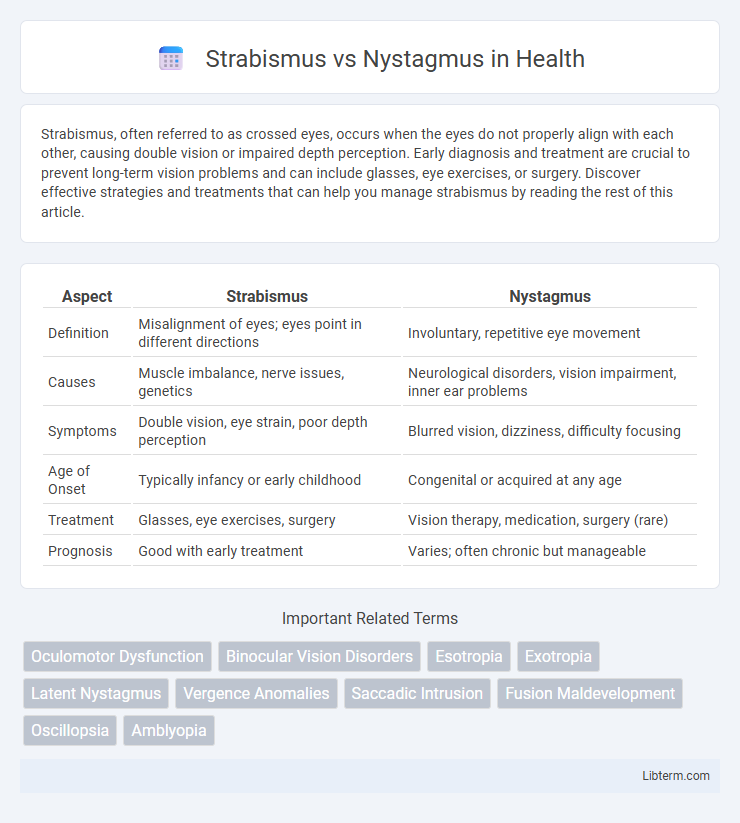Strabismus, often referred to as crossed eyes, occurs when the eyes do not properly align with each other, causing double vision or impaired depth perception. Early diagnosis and treatment are crucial to prevent long-term vision problems and can include glasses, eye exercises, or surgery. Discover effective strategies and treatments that can help you manage strabismus by reading the rest of this article.
Table of Comparison
| Aspect | Strabismus | Nystagmus |
|---|---|---|
| Definition | Misalignment of eyes; eyes point in different directions | Involuntary, repetitive eye movement |
| Causes | Muscle imbalance, nerve issues, genetics | Neurological disorders, vision impairment, inner ear problems |
| Symptoms | Double vision, eye strain, poor depth perception | Blurred vision, dizziness, difficulty focusing |
| Age of Onset | Typically infancy or early childhood | Congenital or acquired at any age |
| Treatment | Glasses, eye exercises, surgery | Vision therapy, medication, surgery (rare) |
| Prognosis | Good with early treatment | Varies; often chronic but manageable |
Overview of Strabismus and Nystagmus
Strabismus is a visual disorder characterized by the misalignment of the eyes, causing one eye to turn inward, outward, upward, or downward, which often leads to double vision or impaired depth perception. Nystagmus involves involuntary, repetitive eye movements that can be horizontal, vertical, or rotary, typically resulting in reduced visual acuity and difficulties with focus. Both conditions affect ocular motor control but differ in their manifestations, underlying causes, and treatment approaches.
Key Differences Between Strabismus and Nystagmus
Strabismus is a condition characterized by the misalignment of the eyes, where one or both eyes deviate inward, outward, upward, or downward, leading to impaired binocular vision and potential amblyopia. Nystagmus involves involuntary, repetitive eye movements, which can be horizontal, vertical, or rotary, resulting in reduced visual acuity and difficulties with steady fixation. Key differences include the nature of eye movement--static misalignment in strabismus versus dynamic oscillations in nystagmus--and their distinct impacts on vision and eye coordination.
Causes of Strabismus
Strabismus is caused by abnormalities in the eye muscles, nerve damage, or brain conditions affecting eye alignment, leading to misaligned eyes. In contrast, nystagmus results from neurological or inner ear issues causing involuntary eye movements. Understanding these distinct causes is crucial for accurate diagnosis and effective treatment planning.
Causes of Nystagmus
Nystagmus is primarily caused by neurological or sensory defects affecting the brainstem or inner ear, such as congenital abnormalities, vestibular disorders, or optic nerve damage. It can also result from acquired conditions like multiple sclerosis, stroke, or head trauma that disrupt normal eye movement control. Unlike strabismus, which is mainly due to misalignment of the eyes from muscle or nerve issues, nystagmus involves involuntary, rhythmic eye oscillations linked to neural pathologies.
Common Symptoms and Signs
Strabismus presents with symptoms such as misaligned eyes, double vision, and difficulty focusing, often noticeable as one eye turning inward, outward, upward, or downward. Nystagmus is characterized by involuntary, rhythmic eye movements, which can cause blurred vision, dizziness, and a sense of oscillation. Both conditions may lead to reduced visual acuity and depth perception challenges, but strabismus primarily involves eye misalignment while nystagmus involves abnormal eye movement patterns.
Diagnostic Approaches for Each Condition
Strabismus diagnosis primarily relies on comprehensive eye exams including the Hirschberg test, cover test, and assessment of ocular motility to detect misalignment of the eyes. Nystagmus diagnosis involves detailed observation of involuntary eye movements using video nystagmography (VNG) or electronystagmography (ENG), alongside neurological evaluation and imaging to identify underlying causes. Both conditions may require specialized tools like optical coherence tomography (OCT) or MRI to support accurate diagnosis and guide treatment plans.
Impact on Vision and Quality of Life
Strabismus causes misalignment of the eyes, leading to double vision, impaired depth perception, and potential amblyopia, significantly affecting daily tasks and social interactions. Nystagmus involves involuntary eye movements that result in blurred or unstable vision, causing difficulty with reading, driving, and recognizing faces. Both conditions can reduce quality of life by limiting visual function and increasing psychological stress.
Treatment Options for Strabismus
Strabismus treatment options include corrective glasses, prism lenses, vision therapy, and eye muscle surgery aimed at realigning the eyes to improve binocular vision. In some cases, botulinum toxin injections are used to temporarily paralyze overactive muscles, facilitating alignment correction. Early intervention is critical to prevent amblyopia and improve long-term visual outcomes in patients with strabismus.
Treatment Options for Nystagmus
Treatment options for nystagmus primarily include corrective lenses, such as glasses or contact lenses, to improve vision and reduce eye strain. In more severe cases, specialized surgical procedures like the Kestenbaum surgery can reposition the eyes to reduce involuntary movements and enhance visual stability. Pharmacological treatments, including gabapentin or memantine, may also be prescribed to help control the oscillations associated with nystagmus.
Prognosis and Long-Term Management
Strabismus prognosis often improves with early intervention including glasses, patching, or surgery, aiming to restore binocular vision and prevent amblyopia; however, untreated cases can lead to permanent vision impairment. Nystagmus management focuses on addressing underlying causes and relieving symptoms using medications, prisms, or surgery, although congenital forms typically persist lifelong with stable vision. Long-term care for both conditions involves regular ophthalmic evaluations to monitor vision changes and adapt treatment plans for optimal visual development and quality of life.
Strabismus Infographic

 libterm.com
libterm.com